engine CITROEN C5 2021 Owners Manual
[x] Cancel search | Manufacturer: CITROEN, Model Year: 2021, Model line: C5, Model: CITROEN C5 2021Pages: 228, PDF Size: 6.78 MB
Page 4 of 228
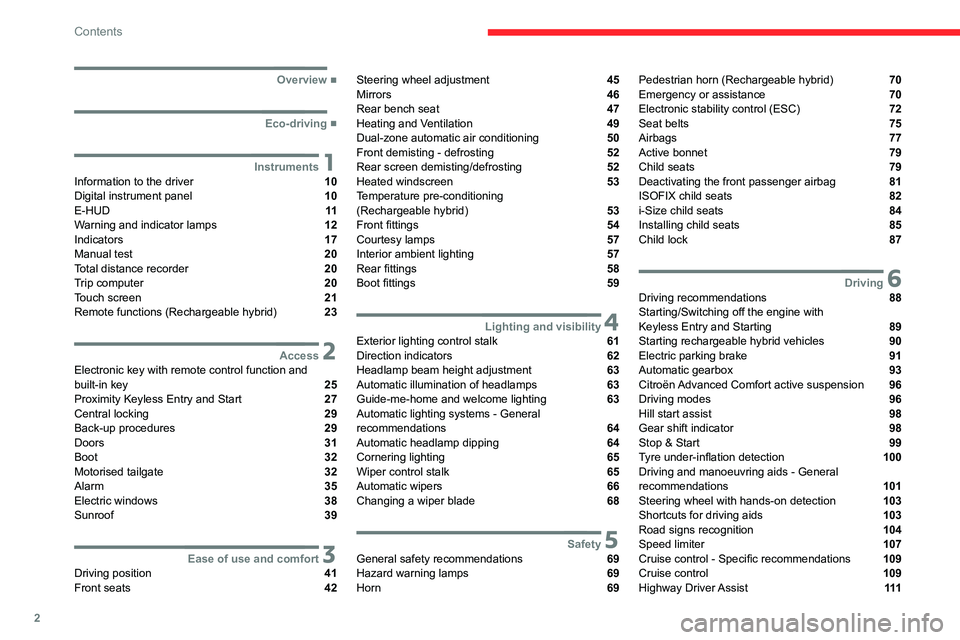
2
Contents
■
Overview
■
Eco-driving
1InstrumentsInformation to the driver 10
Digital instrument panel 10
E-HUD 11
Warning and indicator lamps 12
Indicators 17
Manual test 20
Total distance recorder 20
Trip computer 20
Touch screen 21
Remote functions (Rechargeable hybrid) 23
2AccessElectronic key with remote control function and
built-in key 25
Proximity Keyless Entry and Start 27
Central locking 29
Back-up procedures 29
Doors 31
Boot 32
Motorised tailgate 32
Alarm 35
Electric windows 38
Sunroof 39
3Ease of use and comfortDriving position 41
Front seats 42
Steering wheel adjustment 45
Mirrors 46
Rear bench seat 47
Heating and Ventilation 49
Dual-zone automatic air conditioning 50
Front demisting - defrosting 52
Rear screen demisting/defrosting 52
Heated windscreen 53
Temperature pre-conditioning
(Rechargeable hybrid)
53
Front fittings 54
Courtesy lamps 57
Interior ambient lighting 57
Rear fittings 58
Boot fittings 59
4Lighting and visibilityExterior lighting control stalk 61
Direction indicators 62
Headlamp beam height adjustment 63
Automatic illumination of headlamps 63
Guide-me-home and welcome lighting 63
Automatic lighting systems - General
recommendations
64
Automatic headlamp dipping 64
Cornering lighting 65
Wiper control stalk 65
Automatic wipers 66
Changing a wiper blade 68
5SafetyGeneral safety recommendations 69
Hazard warning lamps 69
Horn 69
Pedestrian horn (Rechargeable hybrid) 70
Emergency or assistance 70
Electronic stability control (ESC) 72
Seat belts 75
Airbags 77
Active bonnet 79
Child seats 79
Deactivating the front passenger airbag 81
ISOFIX child seats 82
i-Size child seats 84
Installing child seats 85
Child lock 87
6DrivingDriving recommendations 88
Starting/Switching off the engine with
Keyless Entry and Starting
89
Starting rechargeable hybrid vehicles 90
Electric parking brake 91
Automatic gearbox 93
Citroën Advanced Comfort active suspension 96
Driving modes 96
Hill start assist 98
Gear shift indicator 98
Stop & Start 99
Tyre under-inflation detection 100
Driving and manoeuvring aids - General
recommendations
101
Steering wheel with hands-on detection 103
Shortcuts for driving aids 103
Road signs recognition 104
Speed limiter 107
Cruise control - Specific recommendations 109
Cruise control 109
Highway Driver Assist 111
Page 5 of 228

3
Contents
Highway Driver Assist 2.0 111
Adaptive cruise control 11 2
Lane positioning assist 11 6
Speed adjustment during cornering 11 9
Semi-automatic lane changing 120
Active Safety Brake with Collision Risk Alert and
Intelligent emergency braking assistance
124
Distraction detection 128
Active lane departure warning system 129
Long-distance blind spot monitoring 131
Parking sensors 132
Top Rear Vision 134
Top 360 Vision 135
Rear traffic alert 137
7Practical informationCompatibility of fuels 140
Refuelling 140
Rechargeable hybrid system 141
Charging the traction battery (Rechargeable
hybrid engine)
148
Towing device 150
Towing device with quickly detachable towball 151
Roof bars 154
Very cold climate screen 155
Snow chains 155
Energy economy mode 156
Bonnet 156
Engine compartment 158
Checking levels 158
Checks 159
Free-wheeling 161
Advice on care and maintenance 162
8In the event of a breakdownWarning triangle 165
Tool kit 165
Temporary puncture repair kit 166
Spare wheel 169
Changing a bulb 171
Fuses 173
12
V battery
/ Accessory batteries 173
Towing the vehicle 178
9Technical dataEngine technical data and towed loads 181
Petrol engines 182
Rechargeable hybrid engine 183
Dimensions 184
Identification markings 184
10 MYCITROËN DRIVE PLUS - MYCITROËN PLAY PLUS
First steps 185
Customisation 188
Steering mounted controls 189
Applications 190
Voice commands 190
Navigation 191
Connectivity 192
Mirror Screen 194
Media 195
Phone 197
Settings 198
Help 199
11Event data recorders
■
Alphabetical index
■
Appendix
Page 6 of 228
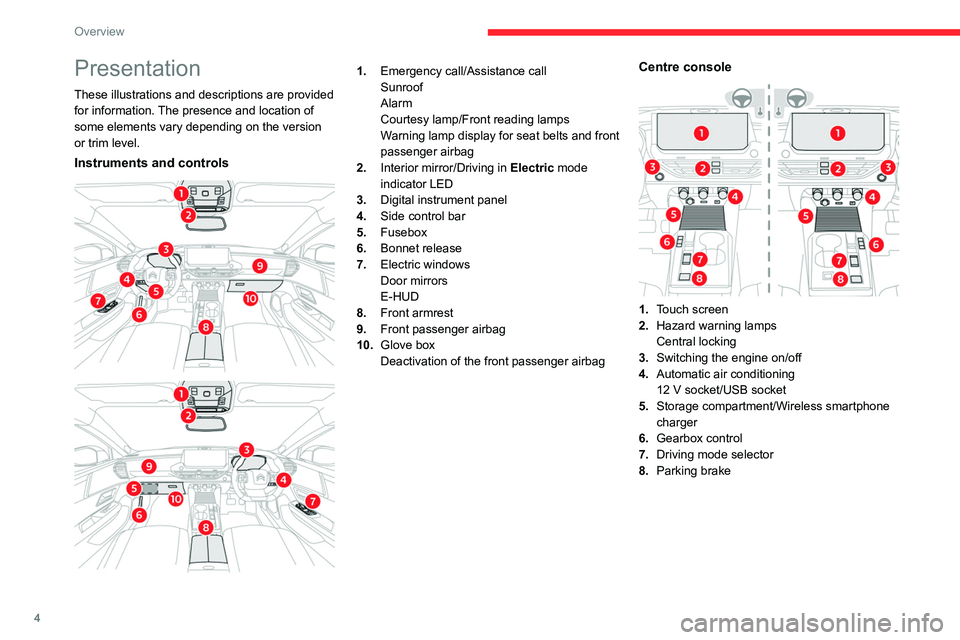
4
Overview
Presentation
These illustrations and descriptions are provided
for information. The presence and location of
some elements vary depending on the version
or trim level.
Instruments and controls
1. Emergency call/Assistance call
Sunroof
Alarm
Courtesy lamp/Front reading lamps
Warning lamp display for seat belts and front
passenger airbag
2. Interior mirror/Driving in Electric mode
indicator LED
3. Digital instrument panel
4. Side control bar
5. Fusebox
6. Bonnet release
7. Electric windows
Door mirrors
E-HUD
8. Front armrest
9. Front passenger airbag
10. Glove box
Deactivation of the front passenger airbagCentre console
1.Touch screen
2. Hazard warning lamps
Central locking
3. Switching the engine on/off
4. Automatic air conditioning
12
V socket/USB socket
5. Storage compartment/Wireless smartphone
charger
6. Gearbox control
7. Driving mode selector
8. Parking brake
Page 8 of 228
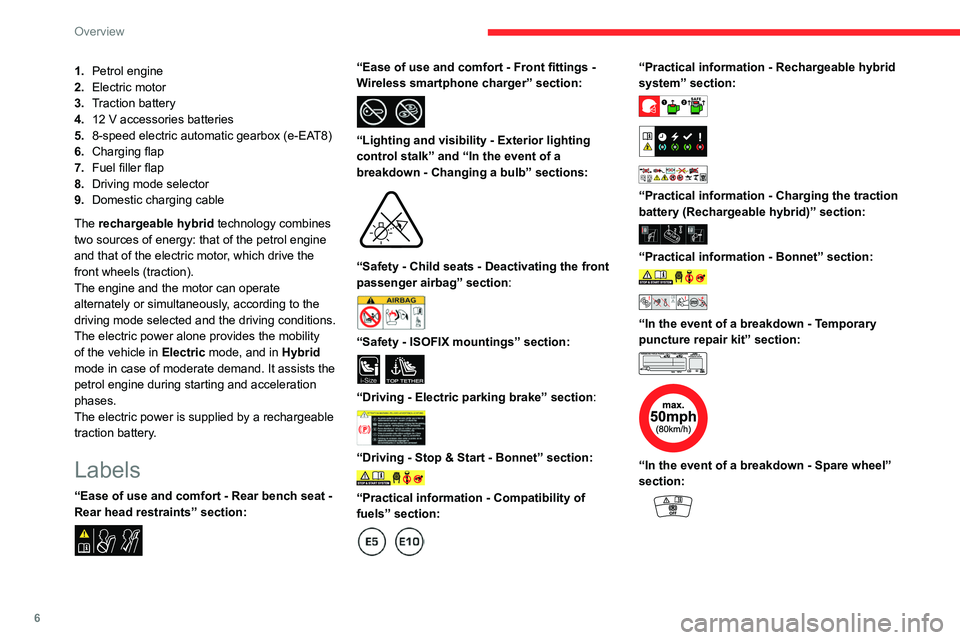
6
Overview
1.Petrol engine
2. Electric motor
3. Traction battery
4. 12 V accessories batteries
5. 8-speed electric automatic gearbox (e-EAT8)
6. Charging flap
7. Fuel filler flap
8. Driving mode selector
9. Domestic charging cable
The rechargeable hybrid technology combines
two sources of energy: that of the petrol engine
and that of the electric motor, which drive the
front wheels (traction).
The engine and the motor can operate
alternately or simultaneously, according to the
driving mode selected and the driving conditions.
The electric power alone provides the mobility
of the vehicle in Electric mode, and in Hybrid
mode in case of moderate demand. It assists the
petrol engine during starting and acceleration
phases.
The electric power is supplied by a rechargeable
traction battery.
Labels
“Ease of use and comfort - Rear bench seat -
Rear head restraints” section:
“Ease of use and comfort - Front fittings -
W ireless smartphone charger” section:
“Lighting and visibility - Exterior lighting
control stalk” and “In the event of a
breakdown
- Changing a bulb” sections:
“Safety - Child seats - Deactivating the front
passenger airbag” section :
“Safety - ISOFIX mountings” section:
i-SizeTOP TETHER
“Driving - Electric parking brake” section:
“Driving - Stop & Start - Bonnet” section:
“Practical information - Compatibility of
fuels” section:
“Practical information - Rechargeable hybrid
system” section:
“Practical information - Charging the traction
battery (Rechargeable hybrid)” section:
“Practical information - Bonnet” section:
“In the event of a breakdown - Temporary
puncture repair kit” section:
“In the event of a breakdown - Spare wheel”
section:
Page 10 of 228
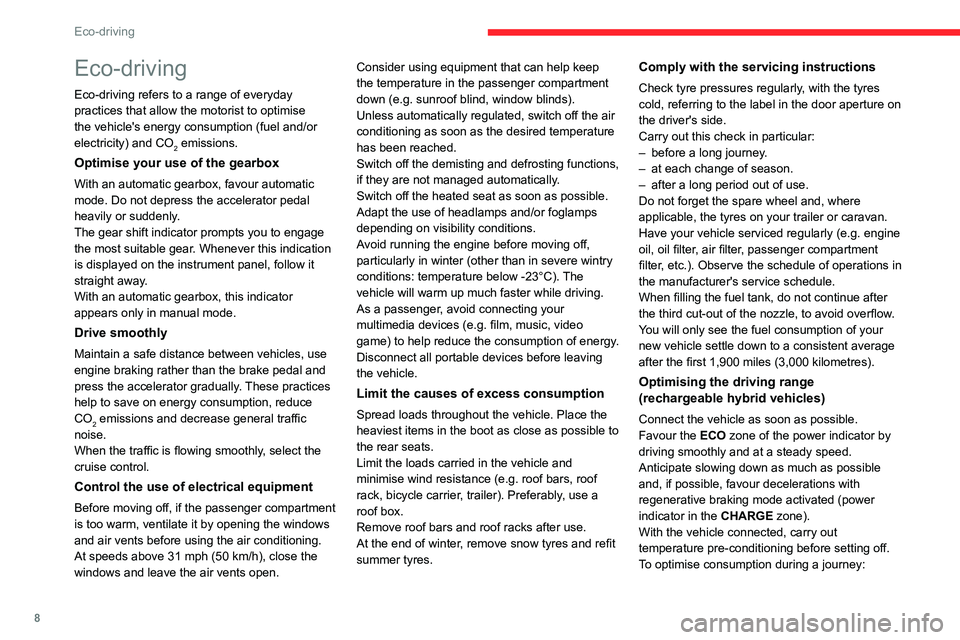
8
Eco-driving
Eco-driving
Eco-driving refers to a range of everyday
practices that allow the motorist to optimise
the vehicle's energy consumption (fuel and/or
electricity) and CO
2 emissions.
Optimise your use of the gearbox
With an automatic gearbox, favour automatic
mode. Do not depress the accelerator pedal
heavily or suddenly.
The gear shift indicator prompts you to engage
the most suitable gear. Whenever this indication
is displayed on the instrument panel, follow it
straight away.
With an automatic gearbox, this indicator
appears only in manual mode.
Drive smoothly
Maintain a safe distance between vehicles, use
engine braking rather than the brake pedal and
press the accelerator gradually. These practices
help to save on energy consumption, reduce
CO
2 emissions and decrease general traffic
noise.
When the traffic is flowing smoothly, select the
cruise control.
Control the use of electrical equipment
Before moving off, if the passenger compartment
is too warm, ventilate it by opening the windows
and air vents before using the air conditioning.
At speeds above 31
mph (50 km/h), close the
windows and leave the air vents open. Consider using equipment that can help keep
the temperature in the passenger compartment
down (e.g.
sunroof blind, window blinds).
Unless automatically regulated, switch off the air
conditioning as soon as the desired temperature
has been reached.
Switch off the demisting and defrosting functions,
if they are not managed automatically.
Switch off the heated seat as soon as possible.
Adapt the use of headlamps and/or foglamps
depending on visibility conditions.
Avoid running the engine before moving off,
particularly in winter (other than in severe wintry
conditions: temperature below -23°C). The
vehicle will warm up much faster while driving.
As a passenger, avoid connecting your
multimedia devices (e.g. film, music, video
game) to help reduce the consumption of energy.
Disconnect all portable devices before leaving
the vehicle.
Limit the causes of excess consumption
Spread loads throughout the vehicle. Place the
heaviest items in the boot as close as possible to
the rear seats.
Limit the loads carried in the vehicle and
minimise wind resistance (e.g.
roof bars, roof
rack, bicycle carrier, trailer). Preferably, use a
roof box.
Remove roof bars and roof racks after use.
At the end of winter, remove snow tyres and refit
summer tyres.
Comply with the servicing instructions
Check tyre pressures regularly, with the tyres
cold, referring to the label in the door aperture on
the driver's side.
Carry out this check in particular:
–
before a long journey
.
–
at each change of season.
–
after a long period out of use.
Do not forget the spare wheel and, where
applicable, the tyres on your trailer or caravan.
Have your vehicle serviced regularly (e.g.
engine
oil, oil filter, air filter, passenger compartment
filter, etc.). Observe the schedule of operations in
the manufacturer's service schedule.
When filling the fuel tank, do not continue after
the third cut-out of the nozzle, to avoid overflow.
You will only see the fuel consumption of your
new vehicle settle down to a consistent average
after the first 1,900 miles (3,000 kilometres).
Optimising the driving range
(rechargeable hybrid vehicles)
Connect the vehicle as soon as possible.
Favour the ECO zone of the power indicator by
driving smoothly and at a steady speed.
Anticipate slowing down as much as possible
and, if possible, favour decelerations with
regenerative braking mode activated (power
indicator in the CHARGE zone).
With the vehicle connected, carry out
temperature pre-conditioning before setting off.
To optimise consumption during a journey:
Page 12 of 228

10
Instruments
Information to the driver
Instrument panel
The instrument panel contains all the information
required by the driver on the status of the
vehicle's various systems.
This information appears in the form of indicator
lamps, indicators and messages.
The instrument panel is in the form of a fully
digital panel.
E-HUD
Depending on version, driver information also
appears in the extended head-up display.
For more information on E-HUD, refer to the
corresponding section.
Digital instrument panel
The digital instrument panel can be personalised
using a page system.
Depending on the page displayed, certain
information is hidden or presented differently.
1. Speedometer (mph or km/h)
2. Driving aid in reduced display (if the function
is activated)
Display of speed limit signs 3.
Status of the gearbox
Active driving mode
READY indicator lamp (Rechargeable hybrid)
4.
Fuel gauge and remaining range (miles or
km)
5. T
otal distance recorder (miles or km) (Petrol)
Traction battery charge level and remaining
range (miles or km) (Rechargeable hybrid)
6. Personalisable area:
–
Energy flows (Rechargeable hybrid).
–
Thermal Comfort Consumption
(Rechargeable hybrid).
–
Current media.
–
Driving aids.
–
Navigation (depending on equipment).
–
Rev counter
.
–
Engine temperature.
–
T
rip computer.
7. Power indicator (Rechargeable hybrid)
Information displayed on
the instrument panel
The information displayed on the instrument
panel (e.g.
warning lamps, indicators) may have
a fixed or variable location depending on the
page or the driving aid activated.
For the functions that have indicator lamps for
both operation and deactivation, there is only
one dedicated location.
Page 14 of 228

12
Instruments
Settings
Brightness adjustment is available after
activation of the function.
The system status and settings are memorised
when the ignition is switched off.
Activation/Deactivation
It can be activated/deactivated in the
Settings > Brightness touch screen
application.
►
With the ignition on, press the “ Head-Up
Display
” button to change the function status
(confirmed by the slider moving to the right/left:
function activated/deactivated).
Brightness adjustment
Brightness adjustment is configured in the
Settings > Brightness touch screen
application.
►
With the ignition on, press or move the slider
to the desired setting.
Adjusting the height
► With the ignition on and the control in the
central high position, move the control up/down
to adjust the desired height of the display
.
Warning and indicator
lamps
Displayed as symbols, the warning and indicator
lamps inform the driver of the occurrence of a
malfunction (warning lamps) or of the operating
status of a system (operation or deactivation
indicator lamps). Certain lamps light up in two
ways (fixed or flashing) and/or in several colours.
Associated warnings
The illumination of a lamp may be accompanied
by an audible signal and/or a message displayed
in a screen.
Relating the type of alert to the operating status
of the vehicle allows you to determine whether
the situation is normal or whether a fault has occurred: refer to the description of each lamp
for further information.
When the ignition is switched on
Certain red or orange warning lamps come on
for a few seconds when the ignition is switched
on. These warning lamps should go off as soon
as the engine is started.
For more information on a system or a function,
refer to the corresponding section.
Persistent warning lamp
If a red or orange warning lamp comes on, there
may be fault which needs further investigation.
If a lamp remains lit
The references (1), (2) and (3) in the warning
and indicator lamp description indicate whether
you should contact a qualified professional in
addition to the immediate recommended actions.
(1): You must stop the vehicle
.
Stop as soon as it is safe to do so and switch off
the ignition.
(2): Contact a CITROËN dealer or a qualified
workshop.
(3): Visit a CITROËN dealer or a qualified
workshop.
Page 15 of 228
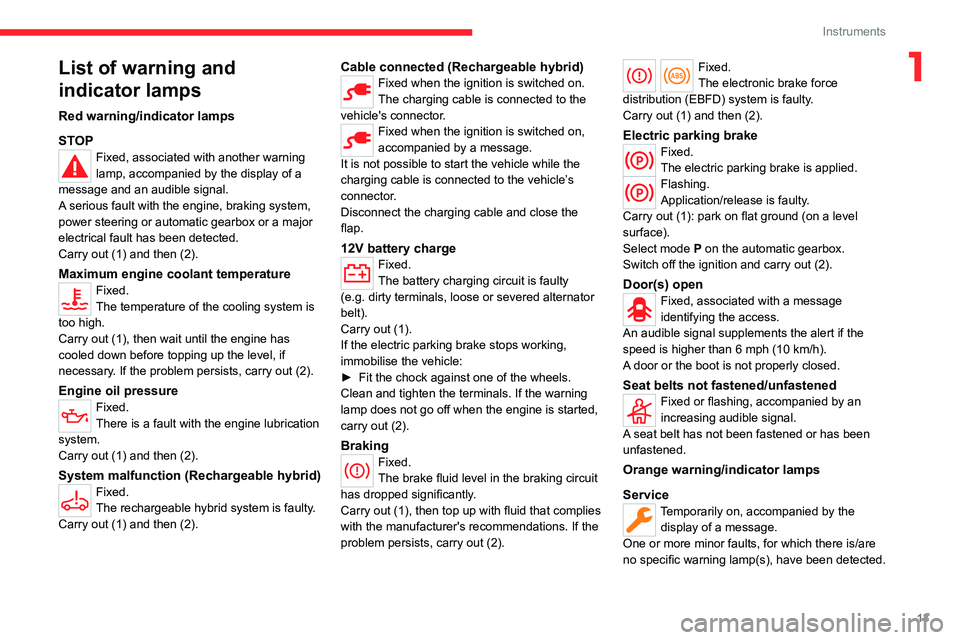
13
Instruments
1List of warning and
indicator lamps
Red warning/indicator lamps
STOP
Fixed, associated with another warning
lamp, accompanied by the display of a
message and an audible signal.
A serious fault with the engine, braking system,
power steering or automatic gearbox or a major
electrical fault has been detected.
Carry out (1) and then (2).
Maximum engine coolant temperatureFixed.
The temperature of the cooling system is
too high.
Carry out (1), then wait until the engine has
cooled down before topping up the level, if
necessary. If the problem persists, carry out (2).
Engine oil pressureFixed.
There is a fault with the engine lubrication
system.
Carry out (1) and then (2).
System malfunction (Rechargeable hybrid)Fixed.
The rechargeable hybrid system is faulty.
Carry out (1) and then (2).
Cable connected (Rechargeable hybrid)Fixed when the ignition is switched on.
The charging cable is connected to the
vehicle's connector.
Fixed when the ignition is switched on,
accompanied by a message.
It is not possible to start the vehicle while the
charging cable is connected to the vehicle’s
connector.
Disconnect the charging cable and close the
flap.
12V battery chargeFixed.
The battery charging circuit is faulty
(e.g.
dirty terminals, loose or severed alternator
belt).
Carry out (1).
If the electric parking brake stops working,
immobilise the vehicle:
►
Fit the chock against one of the wheels.
Clean and tighten the terminals. If the warning
lamp does not go off when the engine is started,
carry out (2).
BrakingFixed.
The brake fluid level in the braking circuit
has dropped significantly.
Carry out (1), then top up with fluid that complies
with the manufacturer's recommendations. If the
problem persists, carry out (2).
Fixed.
The electronic brake force
distribution
(EBFD) system is faulty.
Carry out (1) and then (2).
Electric parking brakeFixed.
The electric parking brake is applied.
Flashing.
Application/release is faulty.
Carry out (1): park on flat ground (on a level
surface).
Select mode
P on the automatic gearbox.
Switch off the ignition and carry out (2).
Door(s) openFixed, associated with a message
identifying the access.
An audible signal supplements the alert if the
speed is higher than 6 mph (10
km/h).
A door or the boot is not properly closed.
Seat belts not fastened/unfastenedFixed or flashing, accompanied by an
increasing audible signal.
A seat belt has not been fastened or has been
unfastened.
Orange warning/indicator lamps
Service
Temporarily on, accompanied by the display of a message.
One or more minor faults, for which there is/are
no specific warning lamp(s), have been detected.
Page 16 of 228

14
Instruments
Identify the cause of the fault using the message
displayed on the instrument panel.
You may be able to deal with some faults
yourself, such as changing the battery in the
remote control.
For other faults, such as with the tyre under-
inflation detection system, carry out (3).
Fixed, accompanied by the display of a
message.
One or more major faults, for which there is/are
no specific warning lamp(s), have been detected.
Identify the cause of the fault using the message
displayed on the instrument panel, then carry
out (3).
Fixed, accompanied by the message
"Parking brake fault".
Automatic release of the electric parking brake is
unavailable.
Carry out (2).
Malfunction (with electric parking brake)Fixed, accompanied by the
message "Parking brake fault".
The vehicle cannot be immobilised with the
engine running.
If manual application and release commands are
not working, the electric parking brake control
lever is faulty.
The automatic functions must be used at all
times and are automatically re-enabled in the
event of a control lever fault.
Carry out (2).
Fixed, accompanied by the
message "Parking brake
fault".
The parking brake is faulty: manual and
automatic functions may not be working.
When stationary, to immobilise the vehicle:
►
Pull and hold the control lever for
approximately 7 to 15 seconds, until the indicator
lamp lights up on the instrument panel.
If this procedure does not work, secure the
vehicle:
►
Park on a level surface.
►
With an automatic gearbox, select
P
, then
place the supplied chocks against one of the
wheels.
Then carry out (2).
Automatic functions deactivated (electric
parking brake)
Fixed.
The "automatic application" (on switching
off the engine) and "automatic release" (on
acceleration) functions are deactivated.
If automatic application/release is no longer
possible:
►
Start the engine.
►
Use the control to apply the parking brake.
►
T
ake your foot fully off the brake pedal.
►
Hold the control pressed in the release
direction for between 10 and 15 seconds.
►
Release the control.
►
Depress and hold the brake pedal.
►
Pull the control in the application direction for
2
seconds. ►
Release the control and the brake pedal.
BrakingFixed.
A minor fault with the braking system has
been detected.
Drive carefully.
Carry out (3).
Anti-lock braking system (ABS)Fixed.
The anti-lock braking system has a fault.
The vehicle retains conventional braking.
Drive carefully at moderate speed, then carry
out (3).
Engine self-diagnostic systemFlashing.
The engine management system has a
fault.
There is a risk that the catalytic converter will be
destroyed.
You must carry out (2).
Fixed.
The emissions control system has a fault.
The warning lamp should go off when the engine
is started.
Carry out (3) without delay.
Fixed.
A minor engine fault has been
detected.
Carry out (3).
Page 18 of 228

16
Instruments
Never drive until completely empty, as
this could damage the emissions control and
injection systems.
Flashing, accompanied by an audible
signal and the display of a message.
The fuel level is very low, the tank (reserve) is
almost empty.
Refuel without delay to avoid running out of
fuel.
Never drive until completely empty, as
this could damage the emissions control and
injection systems.
Pedestrian horn (Rechargeable hybrid)Fixed.
Horn fault detected.
Carry out (3).
Collision Risk Alert/Active Safety BrakeFixed, accompanied by the display of a
message.
The system has been deactivated via the touch
screen.
Flashing.
The system activates and brakes the
vehicle momentarily to reduce the speed of
collision with the vehicle in front.
For more information, refer to the Driving
section.
Fixed, accompanied by a message and
an audible signal.
The system has a fault.
Carry out (3).
Fixed.
The system has a fault.
If these warning lamps come on after the engine
is switched off and then restarted, carry out (3).
Active lane departure warning systemFixed.
The system has been automatically
deactivated or placed on standby.
Flashing.
You are about to cross a broken
lane marking without operating the direction
indicators.
The system is activated, then corrects the
trajectory if it detects a risk of unintentionally
crossing a line or hard shoulder (depending on
version).
For more information, refer to the Driving
section.
Fixed, accompanied by the display
of a message and an audible
signal.
The system has a fault.
Carry out (3).
Stop & StartFixed, accompanied by the display of a
message.
The Stop & Start system has been deactivated
manually.
The engine will not switch off at the next traffic
stop.
Use the touch screen configuration menu to
reactivate the function.
Fixed.
The Stop & Start system has been
deactivated automatically.
The engine will not switch off at the next traffic
stop, if the exterior temperature is:
–
below 0°C.
–
above +35°C.
For more information, refer to the Driving
section.
Flashing then fixed, accompanied by a
message.
The system has a fault.
Carry out (3).
Rear foglampsFixed.
The lamps are on.
Automatic headlamp dippingFixed, accompanied by an audible signal
and a message.
A function or camera malfunction is detected.
Carry out (2).
Green warning/indicator lamps
Stop & Start
Fixed.
When the vehicle stops, the Stop & Start
puts the engine into STOP mode.
Flashing temporarily.
STOP mode is momentarily unavailable
or START mode is automatically triggered.
For more information, refer to the Driving
section.